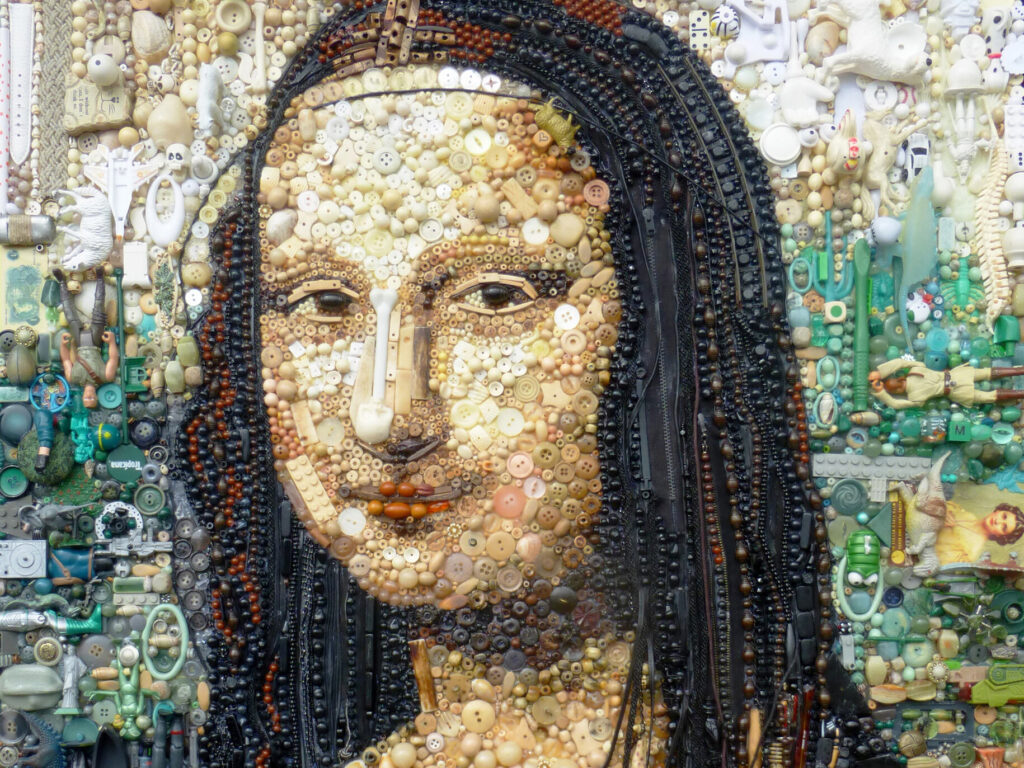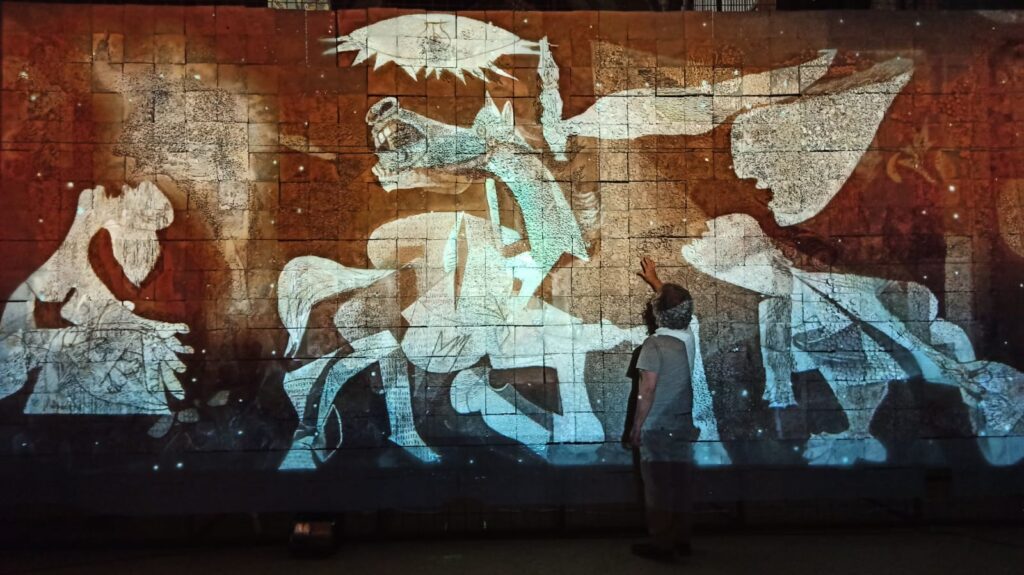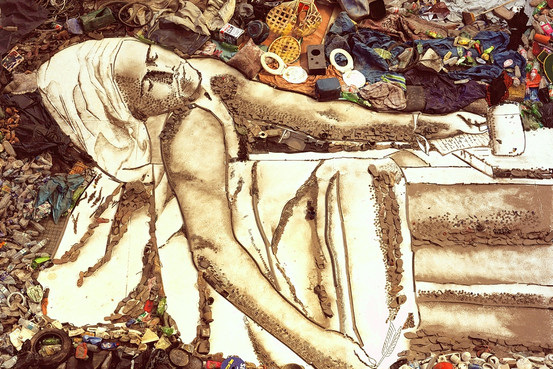Reimagining Masterpieces: Famous Artworks Reinterpreted in Recycled Art
written by art historian & curator
Recycled art, also known as up-cycled or found object art, emerged as a form of artistic expression during the 20th century. The concept gained significant recognition and popularity during the 1960s and 1970s with the rise of the environmental movement and the increasing emphasis on sustainability.
During this time, artists began to experiment with unconventional materials and objects, often salvaged from everyday waste or discarded items. They transformed these materials into artworks, challenging traditional notions of art and exploring themes related to consumerism, waste, and environmental concerns. This marked a departure from the traditional use of art materials like canvas and paint. One notable pioneer of recycled art is the French artist Marcel Duchamp, who is known for his readymade—ordinary objects that he selected and declared to be art. Duchamp’s groundbreaking work in the early 20th century laid the foundation for the conceptual and transformative nature of recycled art.
Join our free online talks:
Today, recycled art provides a compelling platform for artists to reimagine and reinterpret famous artworks, infusing them with new meanings and raising awareness about pressing environmental issues. Through the use of discarded materials, many artists pay tribute to the masters while challenging viewers to reflect upon important cultural and artistic issues. Contemporary artists employ a wide range of recycled materials in their reinterpretations of famous artworks. The choice of materials often depends on the artist’s creative vision, the specific artwork being reinterpreted, and the intended message or concept. We can split recycled materials into several categories: found objects, scrap metal, paper and cardboard, plastic, glass, electronic waste, and natural and organic materials. All materials are to be recuperated from special containers and recycling stations or just from the street.

Artists collect and repurpose various objects, by transforming and integrating them into the artwork, adding texture, depth, and symbolic meaning. Artists may cut, melt, mold, or assemble plastic and derivates from plastic to construct sculptures, installations, or even paintings. Plastic materials serve as a potent symbol of our modern consumer culture and the environmental challenges posed by plastic pollution. Alongside man-made waste, artists sometimes integrate natural materials like tree branches, leaves, seeds, feathers, or shells into their recycled art. These materials connect the artwork to the natural world and highlight the delicate balance between human activity and the environment.
The possibilities for recycled materials in art are virtually endless, limited only by the artist’s imagination and resourcefulness. Artists often experiment with unconventional materials, seeking to repurpose and transform objects that might otherwise be discarded, giving them new purpose and artistic significance.
The Recycling Movement
The recycling movement is a global effort aimed at reducing waste, conserving resources, and minimising the environmental impact of human activities. It encompasses various strategies and initiatives focused on collecting, processing, and reusing materials that would otherwise be discarded as waste. The movement is driven by environmental concerns, sustainability goals, and the recognition of the finite nature of many natural resources.

Contemporary views on the recycling movement emphasise the importance of recycling as part of a broader sustainable approach. Of course, there are limitations. Some critics argue that recycling alone is insufficient to address the magnitude of environmental challenges we face. They highlight that recycling processes require energy, water, and transportation, which can have their own environmental footprint. Additionally, limitations in recycling infrastructure, lack of consumer awareness, and contamination issues can hamper the efficiency and effectiveness of recycling programs. The movement seeks to foster a culture of sustainability, responsible consumption, and waste reduction. By promoting recycling practices and embracing the circular economy principles, the movement aims to create a more environmentally conscious and resource-efficient society.
While art alone may not solve the complex challenges of the recycling movement, it can play a vital role in engaging people, shifting perceptions, inspiring creativity, and fostering a sense of responsibility and connection to the environment. By combining artistic expression with environmental advocacy, art has the potential to make a tangible and meaningful difference in the recycling movement.
“Mona Lisa” Reconstructed by Jane Perkins from found objects
The iconic “Mona Lisa” by Leonardo da Vinci has been a perennial source of inspiration for artists. In the realm of recycled art, we witness interpretations that employ discarded items to recreate this enigmatic masterpiece. Jane Perkins is one of the artists that reimagined da Vinci’s painting according to contemporary times. From buttons, shells, doll parts, zips, different textiles, cutleries, spools, and many other found objects, she intricately recreates the famous Italian beauty. The final collage is ludic, and coloured and provides a beautiful contemporary twist to the classic painting. The reimagining of Perkins not only captures the essence of the original but also serves as a commentary on the modern era’s dependence on technology and its impact on the environment.

“The Starry Night” Revitalized
In 2016, a company in Taiwan recycled 4 million plastic bottles in the recreation of one of the world’s most famous paintings, Van Gogh’s Starry Night. The installation covers 53 hectares of a park outside the Taiwanese city of Keelung. Unison Developing Co. Ltd undertook the project on the occasion of commemorating the 125th anniversary of the Dutch painter’s death. The coloured plastic bottles replicated at a large scale the original painting of Van Gogh, prompting at the same time environmental protection. The piece highlights the interplay between the natural world and the man-made waste that plagues our environment, urging viewers to reflect on the fragility of our ecosystems.
“The Scream” Reinvented by Mark Langan from cardboard boxes
Edvard Munch’s iconic painting, “The Scream,” expresses existential anguish. In the realm of recycled art, this masterpiece is reimagined using recycled paper and cardboard. The reinterpretations evoke the emotional intensity of the original but also serve as a reminder of the collective anxieties surrounding climate change, social issues, and the future of our planet. The U.S. artist Mark Langan used over 30 square feet of cardboard cut by a craft knife to replicate the artwork of the Norwegian painter. He spent 90 hours cutting and laying up the boxes. Langan recovered five boxes from scrap and to modulate the figures he shuddered some of it and used his fingers to sculpt the details.

”Guernica” reimagined by Joan Crous in glass and Earth
Pablo Picasso’s powerful anti-war masterpiece, “Guernica,” has been reinterpreted in recycled art to convey contemporary messages about violence, conflict, and social justice. Joan Crous named her piece L” Ombra (Shadow) to suggest many different meanings such as curiosity, mystery, imagination, suspense, and unknown. The symbolism inserted by Crous in her piece tries to keep alive the original message of the artwork, even after 90 years after its creation, emphasising the role of restoration and memory in today’s society. In 1994 she innovated a glass making technique but for this particular work, Crous did not buy the glass but used the recycled materials she happened upon. The artist employs discarded materials to create impactful installation that evoke the same sense of horror and tragedy as the original painting.
”Marat” by Vik Muniz
The Brazilian artist Vik Muniz is one of the most important personalities for the recycling art movement. He is a specialist in reconstructing masterpieces with recycled materials. Muniz uses everything from trash, food waste, wires, puzzles to dust. The artwork in question makes referral to the famous neoclassic painting by the French artist Jacques-Louis David. Muniz recreated the painting with chocolate, dirt and trash and then photographed it.

Recycled art continues to evolve and gain recognition as a valid and significant art form. This eco-conscious field of art has been embraced by artists worldwide, with numerous exhibitions, installations, and art movements dedicated to this creative approach. Recycled art serves as a powerful medium for expressing environmental concerns, promoting sustainability, and challenging the perception of waste in contemporary society. It is acknowledged that recycling alone is not a panacea, and efforts must also focus on waste reduction, circular economy principles, technological advancements, education, and social justice to achieve meaningful and lasting environmental change.
In summary, contemporary artists reinvent famous artworks with recycled materials to raise awareness about consumerism, celebrate creativity and resourcefulness, provoke thought and conversation, and honour the artistic legacy. Through these reinventions, they offer a fresh perspective on familiar works while addressing pressing issues of our time.
GET MORE FROM LEVEL


Leave a Reply